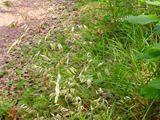Native Plants

Q. Who is Mr. Smarty Plants?
A: There are those who suspect Wildflower Center volunteers are the culpable and capable culprits. Yet, others think staff members play some, albeit small, role. You can torture us with your plant questions, but we will never reveal the Green Guru's secret identity.
Did you know you can access the Native Plant Information Network with your web-enabled smartphone?
Ask Mr. Smarty Plants is a free service provided by the staff and volunteers at the Lady Bird Johnson Wildflower Center.

rate this answer
Wednesday - November 21, 2007
From: Alexandria, VA
Region: Mid-Atlantic
Topic: Erosion Control
Title: Plants to control hillside erosion in Virginia.
Answered by: Nan Hampton
QUESTION:
Good Morning, Mr Smarty Plants, I need your advice and guidance. I live in a condo complex in Virginia and we have a hill/slope that is eroding. It also has two very nice tall trees that partially shade the soil. The soil is poor quality, many rocks, and washes away when it rains or snows. If my memory is correct, I had heard there was certain types of wildflowers that will hold the soil. What type of perennial wildflowers can we use that will grow in poor soil on a slope? Or do you have any other recommenations on what to plant on a slope/hill that would look beautiful and reduce errosion. Thank You for your assistance E. HoganANSWER:
Good morning to you from Mr. Smarty Plants!Grasses are what you need to get started with erosion control on your hillside. They are the best plants for controlling erosion because of the extensive fibrous root systems they develop.
Here are several attractive grasses native to Virginia that will grow in partial shade:
Bouteloua curtipendula (sideoats grama)
Chasmanthium latifolium (Inland sea oats)
Elymus canadensis (Canada wildrye)
Eragrostis intermedia (plains lovegrass)
Melica nitens (threeflower melicgrass)
Panicum virgatum (switchgrass)
Schizachyrium scoparium (little bluestem)
Tridens flavus (purpletop tridens)
The cheapest way to carry out your project is by sowing grass seeds. However, since you would be sowing the seeds on a slope, you will probably find that rain will wash the seeds away before they have had a chance to germinate. You might be able to find grass plugs available for sale. They will be more expensive than the seeds but would have a better chance of setting their roots before rain could wash them away. Another (alas, more expensive) possibility is to use erosion control blankets to stabilize the erosion area. The erosion-control fabric works by slowing the runoff water and allowing sediments to fall out rather than be washed away. Seeds are sown under the erosion-control material and grow up through the matting when they germinate. You can insert plants into the soil by cutting through the matting. The roots of the plants that are growing through the erosion-control material anchor the soil to stop the erosion. If you use erosion-control blankets made of biodegrable material, they will eventually disappear leaving the plants to control the problem. You can read about a stream bank stabilization project implemented by the Department of Environmental Services, Arlington, Viriginia. Although their problem was not exactly the same as yours, they did use the erosion control blankets with great success.
You might also consider sowing seeds of several wildflowers along with your grass seeds. Here are a few suggestions. You can find more from the list of recommended species for Virginia.
Coreopsis lanceolata (lanceleaf tickseed)
Echinacea purpurea (eastern purple coneflower)
Gaillardia pulchella (firewheel)
Hypericum prolificum (shrubby St. Johnswort)
Penstemon canescens (eastern gray beardtongue)
You can look for nurseries and seed companies that specialize in native plants for your area in our National Suppliers Directory.
More Erosion Control Questions
Native plants to stop pond bank erosion
June 04, 2008 - I recently purchased a home with a small pond in which a nearby stream daylights. The former owner placed large field stone around the pond and the small stream; however, the area around the pond and...
view the full question and answer
Will not cutting grass make its roots stronger?
May 27, 2009 - I live on a lake that has a hill. There is some problem with erosion on the hillside. Our association wants us to not cut the grass to stop the erosion. How does not cutting the grass help the roots g...
view the full question and answer
Landscaping on South Padre Island
June 07, 2008 - I'm in charge of landscaping at my beachfront condo in South Padre Island and find the wind, salt air, and heat challenging for growing almost anything. We would like to incorporate native plants, b...
view the full question and answer
Plants for a steep bank in Virginia
June 23, 2009 - I have a small yard with a 3 foot steep bank that I want to plant on. I am looking for fast growing ground cover. There is some shade but not a lot and has a southern exposure. Ground is a bit roug...
view the full question and answer
Low growing erosion control plants for lakeside in Washington Township NJ
May 12, 2013 - I live on a small lake in Northern NJ and have installed beautiful Boulders along the water to help stop erosion. Now I want to add plants along the property but would like low growing, soil retentio...
view the full question and answer
| Support the Wildflower Center by Donating Online or Becoming a Member today. |

